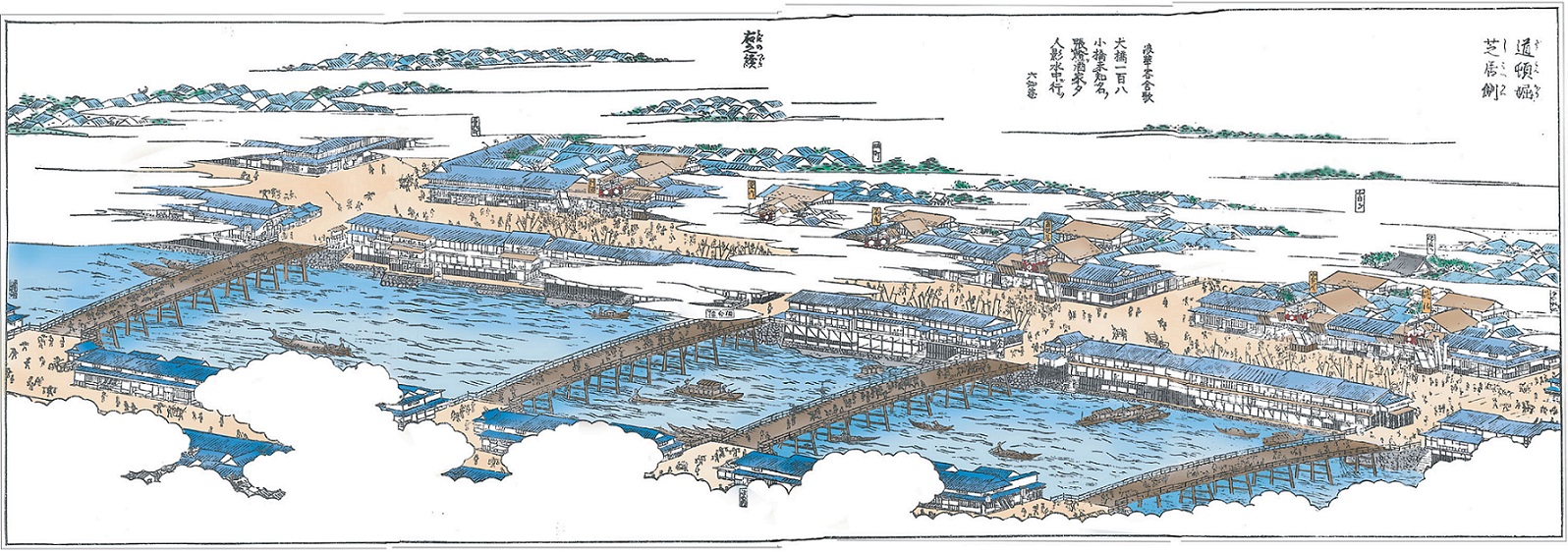Long known as Japan's No. 1 entertainment town

Many people from around the world visit Osaka Minami today.
Even during the Edo period, when Japan was closed to the outside world, foreigners left many records.
A city that offers no shortage of entertainment
In 1691 (Genroku 4), Kaempfer, who visited Osaka, wrote the following:
"There is everything necessary for luxury and sensual entertainment. That is why the Japanese say that Osaka is a city that offers no shortage of entertainment. There are plays every day, both in the public theaters and in the theaters." (1977 Edo Sanpu Travel Journal, translated by Saito Makoto, Heibonsha)
The exploits of Chikamatsu Monzaemon
In 1685 (Jokyo 2), the duo Chikamatsu Monzaemon and Takemoto Gidayu won a complete victory in the Battle of Dotonbori against the Uji Kaga no Jo narrator duo, written by Ihara Saikaku, with their play "Shusse Kagekiyo." They established "New Joruri" and gradually surpassed Kyoto Shijo, the birthplace of Kabuki. Their main works are as follows: All performances premiered at the Takemotoza.
1703 (Genroku 16) "Sonezaki Shinju" (Love suicide at Sonezaki) Ohatsu Tokubei "It has become a model for love" → Shinju boom
1711 (Shotoku 1) "Meido no Hikyaku" (The Courier for Hell)Umekawa Chubei "Seal breaking" → Other authors reworked it into "Kyosei Koihikyaku" and "Koihikyaku Yamato Orai"
1715 (Shotoku 5) "Kokusenya Kassen"(The Battle of Coxinga) 17 months of performances. Historical piece. Coxcenia (Tagawa Fukumatsu), a mixed-race Japanese , calls himself "Watounai" and travels to China to restore the Ming dynasty, which had been destroyed by the Qing.
1720 (Kyoho 5) "Shinju Ten no Amijima"(Love suicide at Amijima) Sewamono. Kamiya Jihei, Koharu, Osan, A journey along the bridges of a travelogue, revised as "Kawasho", 1723,Shinjukinshirei
1721 (6th year of the Kyoho era), "Onnagoroshi Abura no Jigoku" (Woman-Killer in the Oil Hell/The oil Hell Murder), a domestic drama. The complex emotions woven by Kawachiya Tokubei Ozawa, Yohei, Abura-ya, and Okichi, the wife of Teshimaya, the novel title, and the gruesome scenes became a hot topic, and they continue to scare people even today.
Takemoto Gidayu (West Wind) VS. Toyotake Wakadayu (East Wind)
Takemoto Gidayu handed over the management of the Takemoto-za to Takeda Izumo, who was running the Takeda-za, a puppet theatre in the same Dotonbori area, and focused on his art, continuing to produce hits.
In 1703 (16th year of the Genroku era), his direct disciple Takeda Uneme used her popularity to start the Toyotake-za and take the name Toyotake Wakadayu. In the same Dotonbori, the Takemoto-za and Takemoto Gidayu in the west and the Toyotake-za and Toyotake Wakadayu in the east competed for popularity, and Bunraku puppet theater entered its golden age as Japan's greatest form of entertainment.
Related Events
Related Facilities
Latest Features
There are no other articles.